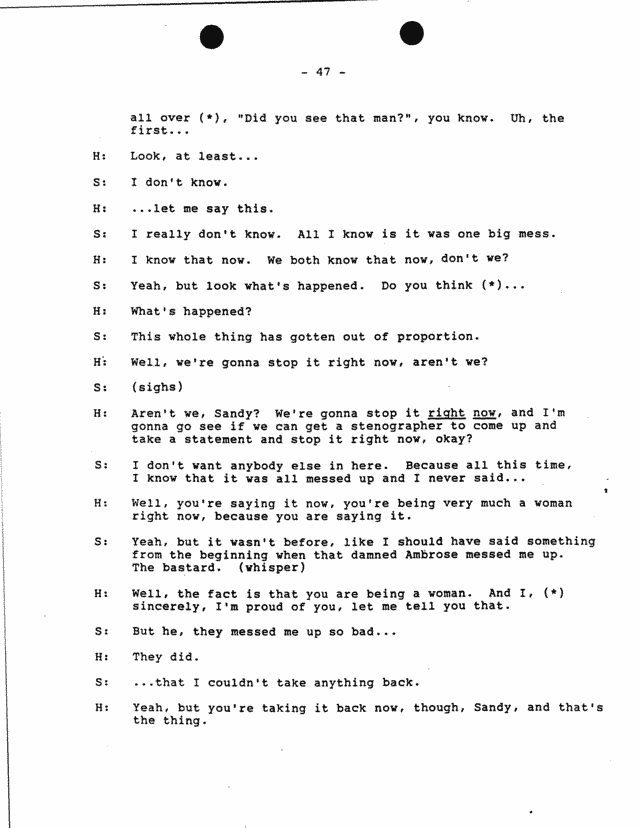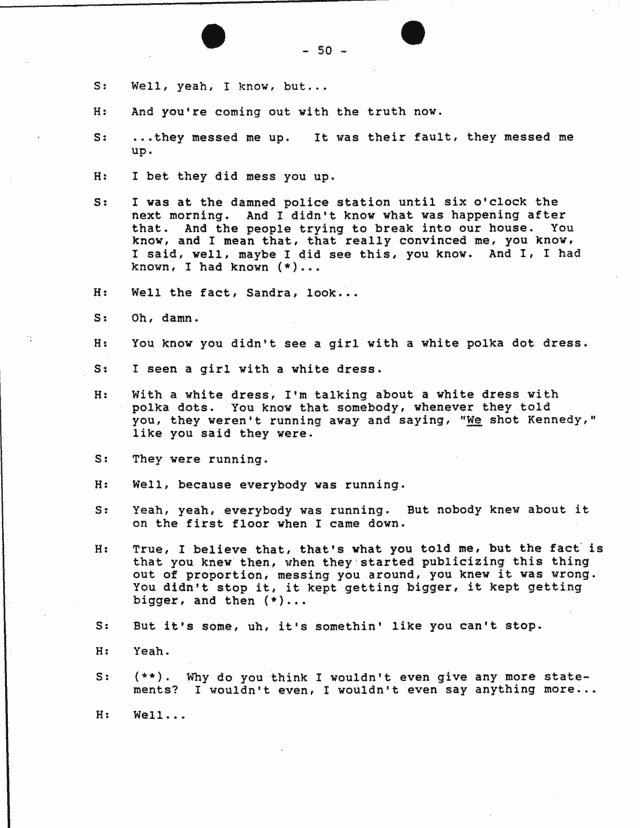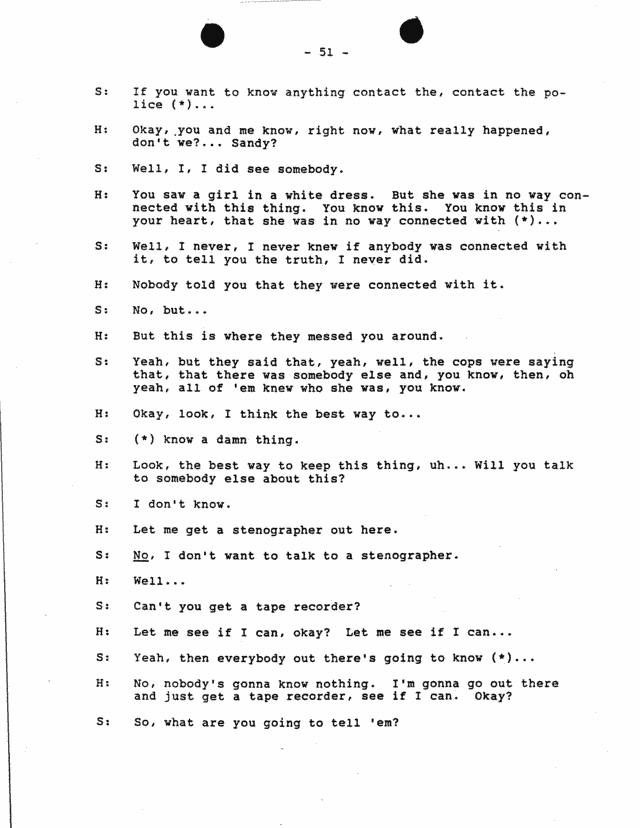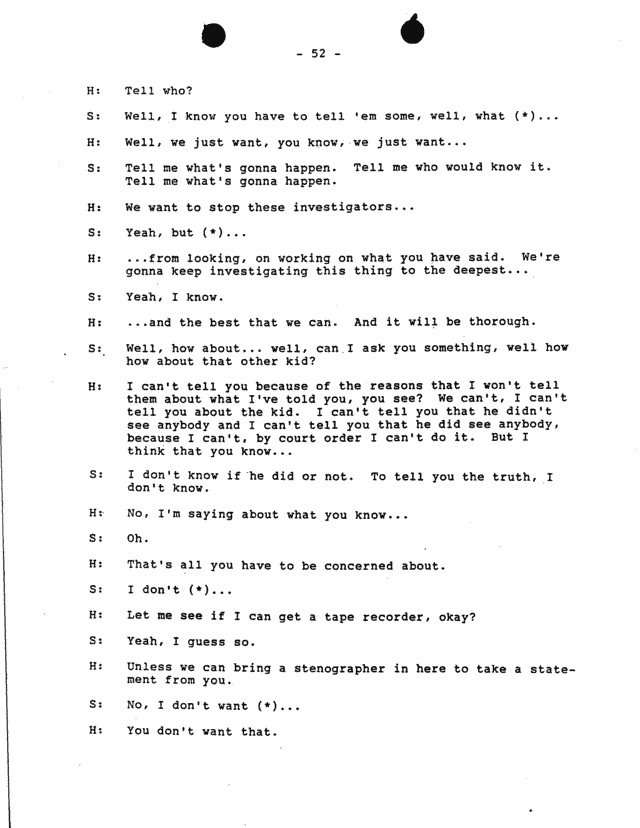The Girl In The Polygraph Test: Part Four
[Original versions posted on my blog on 27 February 2014 as "Parts Five and Six: The Girl In The Polka Dot Dress, The Girl In The Polygraph Test"]Posted below are the final pages from a transcription of the taped interview of Sandra Serrano on 20 June 1968. The excerpts quoted are what I consider highlights of the conversation. Asterisks are original to the transcription, indicating that something is unintelligible. The letter H represents Lt. Enrique "Hank" Hernandez as the speaker, the S represents Sandra Serrano.
1.
[p.46]
H: Sandra, look, uh, I would like this... I don't know how we can do it to stop this thing (*) the easiest way for you so we can stop it, nobody ask you anything else, you go home, be relieved of this thing. I don't know how we can do it. Possibly if I ask you right now and I get a report and we dictate it to someone, you and me, somewhere and, uh, maybe we can stop it there.
S: What kind of report?
H: Well, a report saying that what you have said here is that, it's not the truth.
S: Yeah, but it's, not all of it's... Part of it's true.........................
H: How? [how did the cops "mess you all up"?-dwd]
S: (*) I can remember crying and crying and crying and I can remember saying, "Oh, they told me, 'We shot him.'" I can remember saying that, and then before I know, like, they, "Oh, did you see two people?" "Oh, they were coming." "Where were you at?" "I was outside." "Did you see them run?" "Yes." Uh, you know. The whole big mess. You know, and I can remember crying and crying and crying, you know. Oh, I don't know. They messed me up....................
[p.47]
S: This whole thing has gotten out of proportion.
H: Well, we're gonna stop it right now, aren't we?
S: (sighs)
H: Aren't we, Sandy? We're gonna stop it right now, and I'm gonna go see if we can get a stenographer to come up and take a statement and stop it right now, okay? ............
[p. 48]
S: Yeah, I know, but, it's, it's, it's not that I was telling you all lies. It's not that, I was, I wasn't telling you all lies, because somebody did tell me...
H: Well, they told you "Kennedy has been shot" or "they shot Kennedy" or "he shot Kennedy" and then the policemen started questioning you, the next thing it was two people, the next thing it was a woman in a white and black polka dot dress and, before you knew it, there they are.... You men--, you mentioned [Assistant DA] Ambrose. How did, how do you feel he messed you up?
S: Well, he kept telling me he couldn't, keep, keep remembering. (laughs) I don't know, he messed me up too. I don't know. They put me in, some boy had said something too about, "Yeah, did you see the girl too? She had a white dress with polka dots on." "Oh, yeah, yeah, that was the girl." (laughs)
H: These publicity people that sell papers or whatever, they try...
S: You know. No, that was that boy who made the statement.
H: Oh, then the kitchen. [i.e., Vincent DiPierro's statement about a girl in a polka dot dress, in the kitchen-dwd]
S: Yeah.
H: Yeah. I think that's where you, where you got the white polka dots, or they, whoever it was mixed it in with you and, you know, making a big deal out of something.
S: We were in the back there. I said I'd seen a girl with a white dress on, polka dots or something, and that's what...
H: No, he said polka dots.
S: (*), somebody said something, and before I knew it, yeah, it had polka dots on it. You know. That's, that's what I can remember..........
H: No, no. I'm gonna get this, and I'm gonna put this away, get it in my briefcase and it's gonna be put away. But, the thing [p. 49] is this, we have to make a report to cancel all this, to stop this, see? We have to do it now. And the easiest way is to get a stenographer here to take a statement...............
S: No, okay, but (*) you know. This is gonna be brought up. And what do I say? Well, everybody was messing me up? Yeah. Why aren't you smart enough, you dumbbell? That's what I kept telling myself. What did you, what did you let them do? (*) a damned stupid person...
H: No, you're not.
S: ... (*) told myself that a thousand times.
H: You know what? You would have been stupid if you would have wanted to keep this going when you knew that it was wrong. Then...
S: Well, why in the hell do you think I got an attorney? Did you know I had gotten an attorney?
H: No. Why?
S: Because I was...
H: You thought you were going to do what?
S: Tell him and then let them, let him take care of it. (*), you know, she's my (*) and we haven't had (**)...............
S: We haven't had a meeting yet. We haven't had a meeting yet.
H: You don't have to have a meeting. You don't have to run away from channels. The truth is (*)....................[1]
[p. 50]
S: I was at the damned police station until six o'clock the next morning. And I didn't know what was happening after that. And the people trying to break into our house. You know, and I mean that, that really convinced me, you know, I said, well, maybe I did see this, you know. And I, I had known, I had known (*)...
H: Well the fact, Sandra, look...
S: Oh, damn.
H: You know you didn't see a girl with a white polka dot dress.
S: I seen a girl with a white dress.
H: With a white dress, I'm talking about a white dress with polka dots. You know that somebody, whenever they told you, they weren't running away and saying, "We shot Kennedy," like you said they were.
S: They were running.
H: Well, because everybody was running.
S: Yeah, yeah, everybody was running. But nobody knew about it on the first floor when I came down. [2]
H: True, I believe that, that's when you told me, but the fact is that you knew then, when they started publicizing this thing out of proportion, messing you around, you knew it was wrong. You didn't stop it, it kept getting bigger, it kept getting bigger, and then (*)...
S: But it's some, uh, it's somethin' like you can't stop.
H: Yeah......................
[1. People familiar with this case can be forgiven for thinking it wouldn't have made much difference, but Serrano "going out of channels" by getting a lawyer to "take care of it" on her behalf would've at least presented more of an obstacle than typically encountered -- and typically solved by Hernandez convincing all the "riff-raff" that they never saw what they actually did see-dwd]
[2. Still holding on to her memory that nobody knew about the shooting when she came inside, so "everybody" would not be running at that time; then Hernandez goes right off obscuring everything into "publicity blown out of proportion and you got messed around"-dwd]
2.
[p. 51]
H: Okay, you and me know, right now, what really happened, don't we? ... Sandy?
S: Well, I, I did see somebody.
H: You saw a girl in a white dress. But she was in no way connected with this thing. You know this. You know this in your heart, that she was in no way connected with (*) ...
S: Well, I never, I never knew if anybody was connected with it, to tell you the truth, I never did.
H: Nobody told you that they were connected with it.
S: No, but...
H: But this is where they messed you around.
S: Yeah, but they said that, yeah, well, the cops were saying that, that there was somebody else, and, you know, then, oh yeah, all of 'em knew who she was, you know..............................
[p. 52]
S: Tell me what's gonna happen. Tell me who would know it. Tell me what's gonna happen.
H: We want to stop these investigators...
S: Yeah, but (*)...
H: ...from looking, on working on what you have said. We're gonna keep investigating this thing to the deepest...
S: Yeah, I know.
H: ...and the best that we can. And it will be thorough.
S: Well, how about... well, can I ask you something, well how how about that other kid? [i.e., Vincent DiPierro]
H: I can't tell you because of the reasons that I won't tell them about what I've told you, you see? We can't, I can't tell you about the kid. I can't tell you that he didn't see anybody and I can't tell you that he did see anybody, because I can't, by court order I can't do it. But I think that you know...
S: I don't know if he did or not. To tell you the truth, I don't know.
H: No, I'm saying about what you know...
S: Oh.
H: That's all you have to be concerned about.................
[p. 53]
S: Nobody's gonna know nothing?
H: Nothing. I'm (*) I'm gonna get a statement and it's gonna be filed away...............
(Click on images for slide-show or open in new tab or window to view full-size)








CONCLUSION
To anyone who's made it this far after reading the excerpts, I can only say there's not much one can say. From the very beginning and throughout the interview of Sandra Serrano, Lt. Hernandez displayed the attitude that she was lying about what she said that she saw, and he maintained it against all her protestations to the contrary. It's unclear why he would've been so sure of his own belief, but it's damned hard to find him presenting some basis for it other than strong sentiments and a lot of talk. He just had the certainty that her story was untrue, and he relentlessly insisted on it until she finally gave in: A woman wearing a white dress and maybe a companion were in the hallway or maybe on the fire escape when Sandy Serrano first heard that Robert F. Kennedy had been shot.
Hernandez's mode of operation seems to have been to use his position as a judge of truth and lies to come to favorable, predetermined conclusions. That much included abusing his position of authority through harassment, witness-tampering, manipulating statements, telling lies. There's little reason to doubt that Hernandez used the same tactics to convince Vincent DiPierro (in his polygraph interview) that he got his story about a woman in a polka dot dress "mixed up" from being in contact with Sandra Serrano, just as he convinced Serrano her story got "all messed up" from contact with DiPierro, the media, and the authorities.
Sandra Serrano didn't want a stenographer to take her final statement. She wanted it to be tape-recorded, evidently (and ironically) believing that would be a more reliable record than what someone might write down. And so she officially recanted her allegation of having encountered potential suspects. Vincent DiPierro recanted his allegation of a potential suspect who stood close to Sirhan just before the attack. Larry Arnot had agreed to go along with a conclusion about his confusion until he got on the witness stand and needed clarification on whether he was supposed to tell the whole truth or only what he and Lt. Hernandez had agreed on. (Because, y'know, he had just sworn to tell the whole truth and nothing but the truth.)
A seemingly separate issue is the extent of Jerry Owen's involvement in the case. But if that's unclear, it's partly because Hernandez had an extensive interview with him in which he kept telling him that the polygraph indicated deceitfulness at several points. Ultimately, Hernandez decided that the prosecution should not call Owen as a witness due to this demonstrated unreliability. (Which was a great relief to an otherwise anxious Owen.) One would think that a routine investigative procedure might be to look further into issues surrounding deceit instead of using it as an excuse to excuse someone from being a witness. Owen had merely given a couple of guys a ride into town, one of whom he believed to be Sirhan Sirhan, and with whom he also apparently arranged for the purchase of a horse. Being deemed an unreliable witness would not preclude his significance as a transporter of potential suspects on one occasion, relevant as that is to Sirhan's activities and the issue of how a potential assassin got around to where he needed to go at various points leading up to an attack.
But that would assume a sincere investigation was going on by this time, particularly in the area of running out leads. Closing down loose ends that might point to conspiracy became a prime concern very early on. In the case of Larry Arnot's selling of ammunition, Sirhan had to be alone when buying; otherwise, there was an issue of potential accomplices to be addressed. In the case of Jerry Owen giving a ride to strangers, it seems to have been better to label a minister a chronic liar than for him to appear on any witness stand. And in the case of Serrano and DiPierro, as we've seen, it was necessary to go to great lengths to get rid of the idea of a girl in a polka dot dress. We can say why that happened in the sense of a goal and the result: closing off any issue that might point anywhere other than the sole guilt of Sirhan Sirhan. We can't say why it happened in the sense of where that goal came from.
EPILOGUE
The issue of a girl in a polka dot dress (and her companions) went away. But at about the time Sandra Serrano was talking with Lt. Hernandez, the FBI was still gathering information on any dress that would match the description. In what looked like an internal memo [pp. 212-213] of the LA FBI office (56-156) in a source no longer available on the internets, with dates of "6/18/68," "6/19/68" and "6/25/68," there was mention of an investigation of "Women's Apparel Style Books" from Summer 1962 to Summer 1968, reviewed by a Special Agent with name blacked out.
It was ascertained that the books contained no record or description of a junior petite 3/4 sleeve polka dot dress, having black dots with a white background and further described as having a bib front accentuated with black piping, with a distinctive black bow at the neck.
The FBI determined that Del Monte Sportswear, a women's apparel manufacturer, had produced under the label, "Jodette of California" (distributed to 4,000 outlets throughout the United States), a junior petite, sleeveless dress matching the description but did not currently make such a dress with a 3/4-length sleeve.
As late as 16 August 1968, the Los Angeles FBI office would receive a letter on the subject [p. 319 of that same source].
Gentlemen:
In connection with the picture of a girl wearing a full length white and black polka dot dress in the newspapers recently, and a statement that your Office was very much interested in her, you are advised that on the morning in which Robert Francis Kennedy was shot by Sirhan Bishara Sirhan, a girl answering that general appearance and attire from the back view afforded by the picture used keys to enter an automobile rental office at 7th and Figueroa Street opposite the Statler Hilton Hotel at about 9:00 a.m. and conducted herself as if she belonged and was employed there. I was crossing 7th Street from the Barker Bros. side at the time, and my first observation of her was the back view the same as in the newspapers and I could not help recalling the incident vividly to mind. The girl then had the appearance of being hysterical and tired as if she had been out all night, and upon entering, wandered about the office as if in a daze, and finally sat down behind the counter and put her hands to her face as if taking a nap. About then a bus came by going west on 7th Street which I boarded, and that is my last recollection of the matter. This could well be a blind lead, but it might be worth looking into, as all other possibilities seem to have been exhausted.
[signature and all correspondent information blacked out-dwd]
Return to Table of Contents